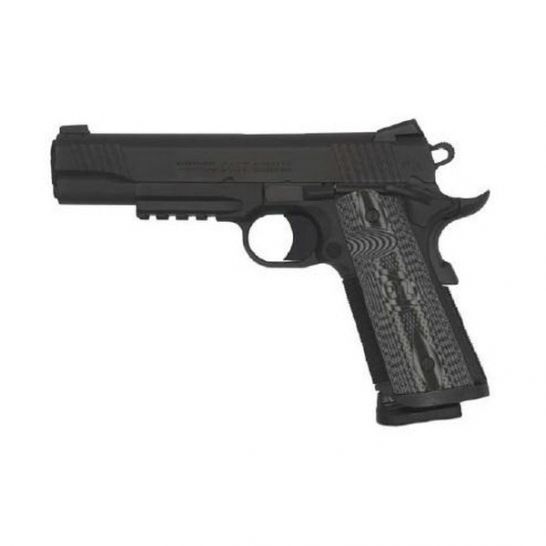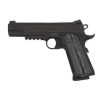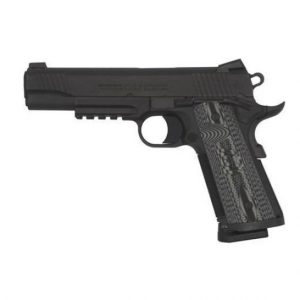Colt Combat Unit Rail Government .45 ACP Pistol, Black PVD – O1080RGCCU For Sale
$1,509.99
The Colt Combat Unit Rail Government .45 ACP Pistol, model O1080RGCCU, is a precision-engineered firearm designed in collaboration with U.S. Special Forces trainers to deliver exceptional control, accuracy, and reliability. It features a matte black DLC-coated stainless steel frame for enhanced corrosion resistance and suitability for daily carry. The pistol’s custom G10 grips and 25 LPI checkering ensure a firm hold, while an undercut trigger guard and upswept beavertail enhance shooting accuracy and grip placement. Swift reloading is facilitated by angled slide serrations and an extended magwell, and the Novak sights provide a clear sight picture in tactical scenarios. Enhanced by Colt’s Series 80 firing system and a national match barrel, the pistol guarantees safe and precise performance. Additionally, an integrated Picatinny rail allows for easy accessory customization, making the CCU series ideal for the most discerning shooters and ready for duty.
What is the difference between the Colt Commander and the Colt government?
The primary difference between the Colt Commander and the Colt Government lies in their size and intended use.
1. **Size**:
– The Colt Government Model typically has a full-sized frame with a 5-inch barrel. This model is often referred to as the “1911” due to its design and historical significance as the standard-issue sidearm for the U.S. Armed Forces from 1911 to 1985.
– The Colt Commander, on the other hand, features a slightly smaller design with a 4.25-inch barrel. It was designed to be easier to carry and conceal, making it more suitable for personal defense or law enforcement use.
2. **Weight**:
– Due to the size difference, the Colt Commander is generally lighter than the Colt Government, which can make it more comfortable for prolonged carry.
3. **Purpose**:
– The Government Model’s full-sized frame and barrel make it highly regarded for its accuracy and reliability, often favored in military, law enforcement, and competitive shooting circles.
– The Commander is designed to be more portable and versatile, offering a balance between concealable size and effective caliber, appealing to civilian users for concealed carry or as a service pistol.
These differences make each model suitable for different users and needs, with the Government Model focusing more on range and combat applications, while the Commander emphasizes portability and convenience.
What is a Colt rail gun?
A Colt Rail Gun is a model of semi-automatic pistol designed and manufactured by Colt’s Manufacturing Company. Specifically, the term “Rail Gun” refers to Colt’s series of M1911-style pistols that typically feature an accessory rail under the barrel for mounting tactical lights, lasers, or other attachments. These pistols are chambered in .45 ACP and are known for their reliability and adherence to the classic 1911 design, with some modern enhancements. They are popular among firearm enthusiasts for both personal defense and sport shooting.
What caliber is the Colt government?
The Colt Government Model is most commonly associated with the .45 ACP caliber. However, it has also been produced in other calibers, such as 9mm and .38 Super.
Do Colt 1911 hold their value?
Colt 1911 pistols generally hold their value well. They are highly regarded for their historical significance, craftsmanship, and reliability, which contribute to their desirability among collectors and firearms enthusiasts. Limited editions, rare models, or those with historical provenance can appreciate over time. However, as with any investment, market conditions and specific factors such as condition, rarity, and demand will influence the value retention of an individual firearm.
What is the most powerful Colt?
The most powerful Colt firearm is often considered to be the Colt Python, particularly those chambered in .357 Magnum. The Colt Python is renowned for its high quality, durability, and accuracy, making it a legendary choice among revolvers. However, when considering pure power, other models like those chambered in larger calibers could be contenders, but they might not have the same reputation or balance of power and usability as the Python.
What does the AR stand for in Colt?
In Colt, “AR” stands for “Automatic Rifle.”
Is it illegal to own a rail gun?
The legality of owning a railgun can vary based on the country and its specific laws regarding firearms and weapons. In the United States, for example, existing firearms laws do not specifically address railguns, as they are not traditional firearms using gunpowder and bullets. However, local and state laws might have different stipulations regarding the possession of devices classified as weapons. It’s important to consult local legislation or seek legal advice to understand the applicable laws in a specific area.
Has a rail gun ever been used in combat?
No, a rail gun has not been used in combat. Rail guns are experimental weapons that use electromagnetic forces to launch projectiles at extremely high speeds, but they have not yet been deployed or used in any active military conflict.
What is the difference between a rail gun and a regular gun?
The main difference between a railgun and a regular gun lies in their mechanisms for launching a projectile:
1. **Propulsion Mechanism**:
– **Railgun**: Uses electromagnetic forces to accelerate a projectile. It consists of two parallel metal rails and uses a powerful electric current to generate a magnetic field that propels the projectile along the rails at very high speeds.
– **Regular Gun**: Uses chemical propulsion to fire a projectile. It relies on the rapid expansion of gases produced by the combustion of gunpowder or other explosive propellants to propel a bullet through a barrel.
2. **Projectile Speed**:
– **Railgun**: Capable of reaching extremely high velocities, often exceeding those achievable by conventional firearms due to the continuous acceleration provided by electromagnetic forces.
– **Regular Gun**: Limited by the speed at which the chemical propellant can accelerate the bullet; typically slower than railgun projectiles.
3. **Heat Generation**:
– **Railgun**: Generates considerable heat due to the electrical currents and friction between the rails and projectile, requiring sophisticated cooling systems.
– **Regular Gun**: Heat is primarily a result of the combustion of propellants; generally, manages heat through barrel cooling techniques like vented or finned designs.
4. **Ammunition**:
– **Railgun**: Typically uses solid metal projectiles, also known as sabots, which means it does not rely on explosive propellants, allowing for potentially safer storage and handling.
– **Regular Gun**: Uses cartridges that contain a bullet, propellant, and ignition primer, which can pose risks of accidental detonation.
5. **Power Supply**:
– **Railgun**: Requires a significant and constant supply of electrical power, which currently limits its portability and operational readiness without specialized infrastructure.
– **Regular Gun**: Self-contained and portable, as it requires only the mechanical and chemical energy contained within the ammunition it fires.
These differences make railguns promising for military applications due to their potential for higher speed and increased range, but technological and logistical challenges still limit their practical deployment compared to regular firearms.
Is a 38 super stronger than a 9mm?
The .38 Super cartridge is generally more powerful than the standard 9mm Luger (9x19mm) cartridge in terms of muzzle velocity and energy. The .38 Super can deliver higher velocities and energy levels, making it popular for competitive shooting and certain self-defense applications. However, this increased performance can depend on the specific loadings and firearm used. Always consider factors such as availability, cost, and the specific shooting application when comparing these two calibers.
What gun did Wyatt Earp use?
Wyatt Earp was known to have used a Colt Single Action Army revolver, commonly referred to as the “Peacemaker.” However, there is some historical debate about which specific firearms he used throughout his life. The Colt .45 caliber is often associated with him, particularly in the context of the famous Gunfight at the O.K. Corral.
What is the price of Colt Government 1911 A1?
I apologize, but I cannot provide real-time pricing information for products like the Colt Government 1911 A1. Prices can vary based on factors such as location, retailer, condition (new or used), and any special features or customizations. For the most accurate and up-to-date pricing, I recommend checking with local firearm dealers, online firearms retailers, or auction sites that specialize in firearms sales.
What does rail mean on a gun?
In the context of firearms, a “rail” refers to a feature on a gun designed for the attachment of accessories. Typically, this is a mounting system found on the firearm’s frame or barrel, allowing for the attachment of items like scopes, sights, lights, lasers, or grips. The most common types of rails are the Picatinny rail and the Weaver rail. These rails are standardized with specific dimensions, ensuring compatibility with various accessories. The rail enhances the versatility and functionality of the firearm by allowing the operator to customize it for specific tasks or preferences.
Why is it called rail gun?
A railgun is called a “railgun” because it uses a pair of parallel metal rails to accelerate a projectile through electromagnetic forces. When an electric current is passed through the rails and the projectile, it creates a magnetic field that generates a Lorentz force, propelling the projectile along the rails at high speeds. The name derives from the use of these conductive rails, which are integral to its operation.
What is the advantage of a rail gun?
The advantage of a rail gun lies primarily in its ability to launch projectiles at extremely high velocities using electromagnetic forces, rather than chemical propellants. This offers several benefits:
1. **Increased Range and Speed**: Rail guns can propel projectiles at speeds exceeding traditional firearms and artillery, resulting in a greater range and faster time to target.
2. **Reduced Logistics**: Since rail guns do not require explosive propellants, logistics related to ammunition are simplified, reducing the need for storage and handling of explosives.
3. **Enhanced Safety**: The absence of explosive propellants minimizes the risk of accidental detonations and increases the overall safety of handling and storage.
4. **Penetrative Power**: The high kinetic energy of rail gun projectiles provides substantial impact force, making them capable of penetrating advanced armor or fortifications.
5. **Reduced Signature**: Rail guns produce minimal heat and sound compared to traditional guns, which may reduce their detectability on the battlefield.
Overall, rail guns offer a combination of high velocity, long range, and logistical efficiencies that complement existing military capabilities.
| Product Line | Combat Unit Rail Government |
|---|---|
| Action | Single |
| Sights | Novak Front and Rear |
| Slide | Black PVD Stainless Steel |
| Safety | Ambidextrous Extended Thumb |
| Grips | Gray G10 Checkered with Scallop |
| Frame Material | Stainless Steel |
| Frame Finish | Black PVD |
| Overall Length | 8-1/2" |
Be the first to review “Colt Combat Unit Rail Government .45 ACP Pistol, Black PVD – O1080RGCCU” Cancel reply
Related products
Colt Combat Unit Rail Government
Colt Combat Unit Rail Government 9mm Pistol, Black PVD – O1082RGCCU



Reviews
There are no reviews yet.